Expert recommendations for caring for eggplants in a greenhouse
In cold regions with an unstable climate, eggplants are planted in greenhouses. The structures protect the crop from rain and wind, frost and dew. To grow vegetables in a greenhouse, you need to know a few simple agrotechnical rules.
How to properly grow eggplants in it and how to get a rich harvest, we will consider further.
Basic requirements for growing in a polycarbonate greenhouse
Polycarbonate greenhouses are smaller in size than greenhouses, so they are in demand among gardeners with small plots. The greenhouse reliably protects eggplants from unfavorable climatic conditions and is easy to assemble and install. Domed or arched models are suitable for planting vegetables. The size of the structure should be proportional to the size of the garden.
Polycarbonate is reliable and retains heat better than glass or film. A greenhouse made from it weighs little and can be moved to a new location at any time. The greenhouse frame must be made of galvanized steel. The frame should not bend from hand pressure, otherwise such a greenhouse will last no more than a year.
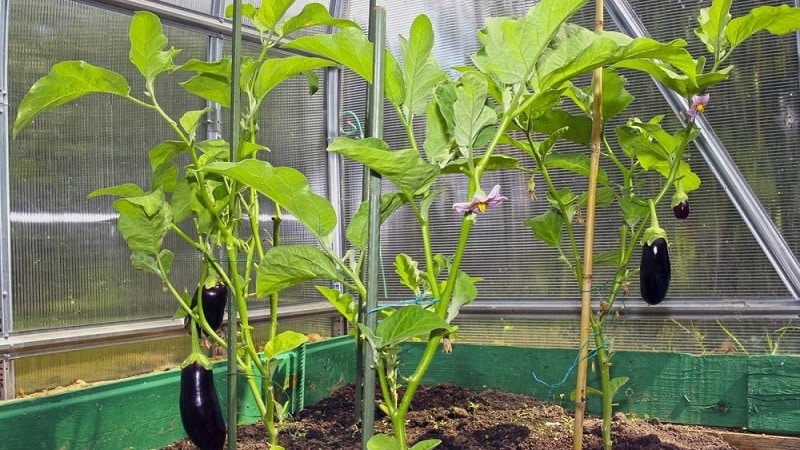
How to choose a greenhouse for planting
The greenhouse must be durable, with a reliable frame. The door and vents play an important role - with their help, the greenhouse is ventilated, which eliminates heat and stuffiness, prevents the development of diseases and the appearance of pests. Doors and windows should open easily and have a reliable latch mechanism.Before purchasing a greenhouse, they think in advance where it will be located.
Important! High-quality and durable greenhouses and greenhouses are made from Premium cellular polycarbonate. This material is expensive, but will last about 20 years.
Preparing the greenhouse before planting eggplants
Preparing a greenhouse for planting eggplants takes place in several stages.
Greenhouse disinfection
Walls, vents and others hard surfaces are washed with a weak solution of potassium permanganate and warm water. You cannot clean polycarbonate with cleaning solutions - abrasive substances will destroy the structure of the material and it will become unusable. After wet cleaning, open the doors and windows to ventilate the greenhouse.
The next stage of disinfection is treatment with bleach. For 10 liters of water you will need 400 g of lime. The ingredients are mixed and left for a day. Apply the product using a spray bottle. A bleach-based solution cleans even heavily contaminated areas.
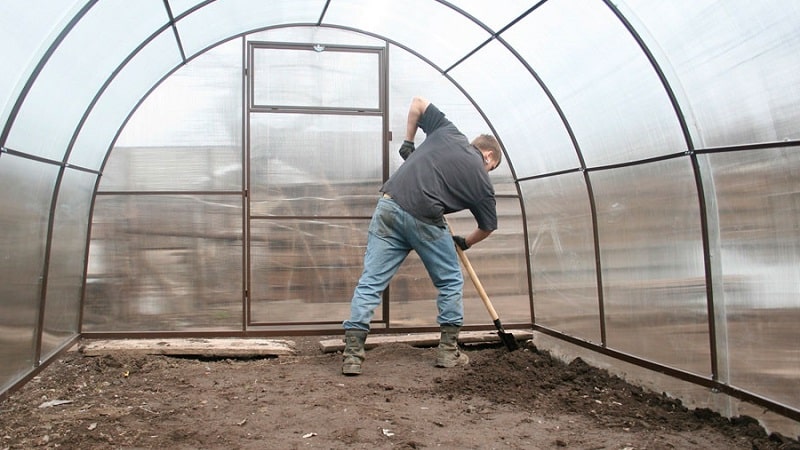
Tillage
Before cultivating the soil, remove all debris from the greenhouse. - remnants of last year's plants, hoses and stakes, foliage and weeds. Gardeners remove the top layer of soil 3-5 cm, after which they disinfect with a sulfur bomb. The procedure is done wearing gloves and a respirator. Keep the structure in smoke for 3-5 days and ventilate the greenhouse. The smoke from the sulfur bomb disinfects the most inaccessible places and crevices.
Planting eggplant seedlings in a polycarbonate greenhouse
Seedlings are planted in early May. The planting pattern depends on the size of the plant. For tall varieties - 70x80 or 90x90, for short varieties - 60x60. Eggplants coexist in the same greenhouse with herbs, onions and legumes. It is not recommended to plant together with tomatoes, potatoes or peppers.
Furrows are made in the beds and warm water is poured into them. The sprout is carefully removed from the seedling and placed in a hole, sprinkling the base of the stem with soil and soil crumbs. It is recommended to lay a layer of straw on the ground - it retains moisture.
It can be useful:
Caring for the first shoots
How to care for the first shoots? In a greenhouse, the rules of cultivation and care differ from those used in open ground.. Particular attention is paid to watering and fertilizing.

Watering
The water temperature for watering eggplants should be at least +20°C. Moisten the beds in the early morning or evening so that the moisture does not evaporate. The interval between watering is 5-7 days.
Twice during the growing period, instead of water, use an infusion based on nettle or burdock.. The folk remedy strengthens the roots of the plant and improves the taste of the fruit. No more than 1 liter of water is consumed per bush. The greenhouse has high humidity, so it is important to follow these recommendations to avoid the development of diseases.
Lighting
Eggplants are sensitive to lack of light, so It is recommended to organize additional lighting in the greenhouse with fluorescent or mercury lamps. The plant should receive at least 10 hours of light and the same amount of darkness per day. If it’s white nights outside, they create artificial darkness.
Top dressing
In the greenhouse eggplants are fertilized with organic and mineral fertilizers. The first group includes chicken droppings, manure, and herbal infusions. They are applied at the root or diluted in water before watering. Mineral components used include superphosphate, potassium salt, and ammonium nitrate.During the season, eggplants are fed 2-3 times with an interval of 10 days. When applying fertilizer, follow the recommendations and dosage.
Important! Why don't eggplants grow in the greenhouse? The reason may lie in improper feeding. Dry and yellow leaves indicate an overabundance of mineral fertilizers. In this case, the beds are watered abundantly and sprinkled with dry lime - the procedure will help wash out excess components from the soil.
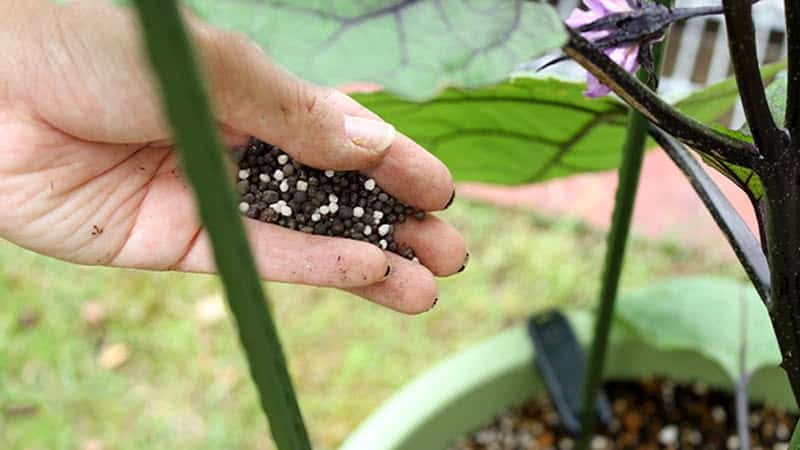
Protection from diseases and pests
In the greenhouse illnesses and pests appear due to excessive humidity and stuffiness. Eggplants suffer from late blight, powdery mildew, and tobacco mosaic virus. Insects include whiteflies, wireworms, and aphids.
To protect the crop, preventive and therapeutic agents are used:
- watering with Bordeaux mixture;
- spraying with whey solution;
- regular ventilation and compliance with crop rotation rules;
- drug "Hom";
- copper sulfate solution;
- means "Maxim" and "Quadris".
Caring for grown eggplants
How to grow eggplants further? A month after planting, reduce the amount of moisture, two weeks before harvesting, watering is stopped. At the same time, additional agrotechnical procedures appear.
Pollination
There are problems with pollination in a greenhouse - unlike open ground, there are fewer pollinating insects. Gardeners carry out the procedure manually. To do this, use a regular painting brush, with the help of which pollen is transferred from male flowers to female ones.
Once a day, gardeners shake the bushes so that pollen falls on other plants. Pollination is also stimulated with the help of the preparations “Epin” or “Rostok”.
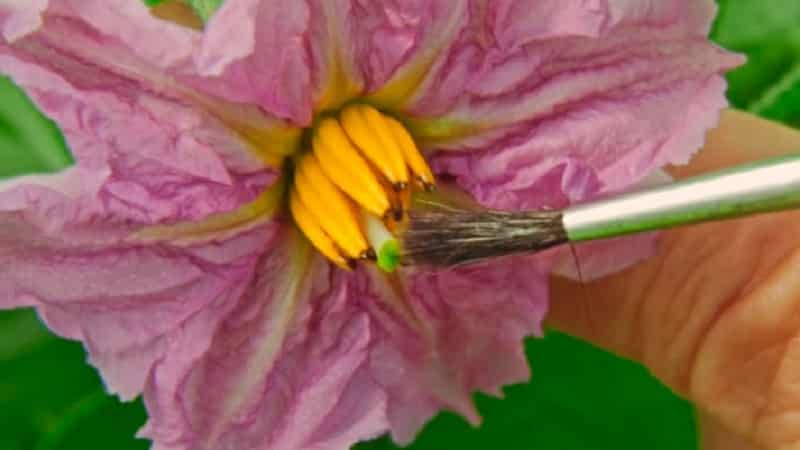
Shaping, tying and pinching
Form eggplants into two stems - small shoots and leaves are removed with garden shears. The main stem is tied with twine to the trellis. One large flower is left in the inflorescence. If this is not done, the eggplants will stop growing and lose their taste. A garter is also necessary to prevent the stems from breaking under the weight of the fruit.
Important! In tall plants, pinching is carried out at the beginning of intensive growth. For short people - two weeks later.
Feeding during pollination and fruiting
The last feeding is carried out 3-3.5 weeks before harvest. It is recommended to use foliar fertilizers - spraying from a spray bottle. Use nettle infusion, copper sulfate solution, and onion peel decoction. The procedure nourishes the stems and leaves, the eggplants fill with color and become glossy.
Possible difficulties that you may encounter when growing eggplants
Difficulties may arise at the stage of growing seedlings. Two weeks after planting, a pick is carried out - the seedlings are transplanted into a larger container. Handle the bushes carefully so as not to damage the still weak and fragile roots. If the root system is damaged during the picking process, the eggplants will not take root in the new container and the seedlings will have to be replanted.
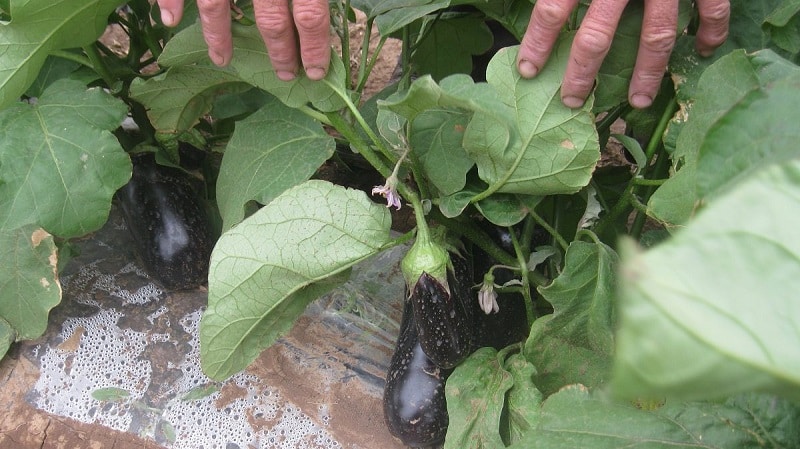
The greenhouse is characterized by high humidity, so it is important to observe the temperature regime and the order of watering. Too wet soil leads to the development of diseases. Summer residents regularly ventilate the greenhouse using windows and doors.
Harvest and storage
Eggplant harvested in mid-August, when the fruits acquire a rich purple color and become elastic. You can’t leave the crop in the garden too long - it will become bitter and dangerous to health.Wipe the eggplants with a dry cloth and for long-term storage place in a cool, dry place. The maximum storage period is no more than one month.
Interesting. Eggplants make tasty and healthy winter preparations - caviar, salads, snacks, pickled and pickled dishes. The fruits are used whole or cut into slices. For piquancy, the vegetable is salted and peppered, onions and garlic, coriander, basil, parsley, and hot pepper are added to the jars. Such preparations are stored for up to one year.
Advice from experienced agronomists
 To grow a tasty and rich harvest, experienced gardeners and summer residents recommend sticking to the rules:
To grow a tasty and rich harvest, experienced gardeners and summer residents recommend sticking to the rules:
- Before planting, disinfect the seed with a solution of potassium permanganate or Bordeaux mixture - the seeds are soaked in the solution for 20 minutes and dried.
- When applying organic and mineral fertilizers, observe the dosage. If the drugs are toxic to humans, use a respirator, gloves and goggles.
- Regularly inspect plants for diseases and pests. If detected, immediately carry out treatment measures.
- For irrigation, use only water at room temperature. Cold weather leads to the development of fungus and infections.
- Maintain compatibility with other vegetables. Do not plant next to tomatoes and bell peppers.
Conclusion
Caring for eggplants in a greenhouse consists of simple agrotechnical rules. Regular watering and fertilizing, timely formation and tying of plants help to grow a good harvest. It is better not to plant tomatoes and eggplants in the same greenhouse; they have common diseases and pests.
Harvest in August, when the stalk turns bright green and the fruits acquire a deep color.Eggplants are versatile in their use - they are used to prepare delicious baked and stewed dishes, as well as winter preparations.